The video of today's National Academies event on forced migration and displacement is now available, including Kalev's remarks on how GDELT is used across the world to map, model and even forecast mass-scale human movement and displacement:
Our ability to describe and project human movement and activity past, present and future is improving as new quantitative data and tools emerge to understand population dynamics. However, in times of crises or other disturbances, the readiness of quantitative data often lags and can be too slow to define real-time dynamics. The integration of qualitative or thick data with quantitative may offer approaches to construct a real-time understanding of forced migration. This webinar will explore these questions: What are the data (qualitative and quantitative) and tools needed to better track human movement and displacement as close to real-time as possible? What are the limits, opportunities, and errors associated with those data? What qualitative data is accessible, and what are the ethics of using it? How do we visualize and communicate these integrated datasets?
